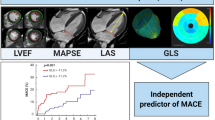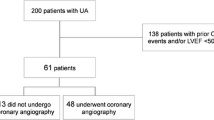Abstract
This study was to evaluate the value of multi-directional strain parameters derived from three-dimensional (3D) speckle tracking echocardiography (STE) for predicting left ventricular (LV) remodeling after ST-elevation myocardial infarction (STEMI) treated with primary percutaneous coronary intervention (PCI) compared with that of two-dimensional (2D) global longitudinal strain (GLS). A total of 110 patients (mean age, 54 ± 9 years) after STEMI treated with primary PCI were enrolled in our study. At baseline (within 24 h after PCI), standard 2D echocardiography, 2D STE and 3D STE were performed to acquire the conventional echocardiographic parameters and strain parameters. At 3-month follow-up, standard 2D echocardiography was repeated to all the patients to determine LV remodeling, which was defined as a 20% increase in LV end-diastolic volume. At 3-month follow-up, LV remodeling occurred in 26 patients (24%). Compared with patients without LV remodeling, patients with remodeling had significantly reduced 2D GLS (−12.5 ± 3.2% vs −15.0 ± 3.1%, p < 0.001), 3D GLS (−9.9 ± 2.2% vs −13.1 ± 2.7%, p < 0.001), 3D global area strain (GAS) (−20.3 ± 3.9% vs −23.3 ± 4.8%, p = 0.005) and 3D global radial strain (GRS) (29.0 ± 7.4% vs 34.3 ± 8.5%, p = 0.007) at baseline, but there is no significant difference in 3D global circumferential strain (GCS) (−12.7 ± 2.9% vs −13.0 ± 3.2%, p = 0.822). Separated multivariate analysis shows that 2D GLS, 3D GLS, 3D GAS and 3D GRS all can be independent predictors of LV remodeling. However, receiver-operating characteristic curve analysis showed that the area under the curve of 3D GLS (0.82) for predicting LV remodeling was significantly higher than that of 2D GLS (0.72, p = 0.034), 3D GAS (0.68, p < 0.001) and 3D GRS (0.68, p < 0.001). In patients after STEMI, 2D GLS, 3D GLS, 3D GAS and 3D GRS but not 3D GCS measured after primary PCI are independent predictors of LV remodeling and 3D GLS is the most powerful predictor among them.



Similar content being viewed by others
References
Shah RU, Henry TD, Rutten-Ramos S, Garberich RF, Tighiouart M, Merz CNB (2015) Increasing percutaneous coronary interventions for ST-segment elevation myocardial infarction in the United States: progress and opportunity. JACC Cardiovasc Interv 8(1_PB):139–146. doi:10.1016/j.jcin.2014.07.017
Dorsey SM, McGarvey JR, Wang H, Nikou A, Arama L, Koomalsingh KJ, Kondo N, Gorman JH, Pilla JJ, Gorman RC, Wenk JF, Burdick JA (2015) MRI evaluation of injectable hyaluronic acid-based hydrogel therapy to limit ventricular remodeling after myocardial infarction. Biomaterials 69:65–75. doi:10.1016/j.biomaterials.2015.08.011
Sutton MGSJ, Sharpe N (2000) Left ventricular remodeling after myocardial infarction pathophysiology and therapy. Circulation 101(25):2981–2988
Vannan MA, Taylor DJ (1992) Ventricular remodelling after myocardial infarction. Br Heart J 68(3):257
O’Gara PT, Kushner FG, Ascheim DD, Casey DE, Chung MK, de Lemos JA, Ettinger SM, Fang JC, Fesmire FM, Franklin BA, Granger CB, Krumholz HM, Linderbaum JA, Morrow DA, Newby LK, Ornato JP, Ou N, Radford MJ, Tamis-Holland JE, Tommaso CL, Tracy CM, Woo YJ, Zhao DX (2013) 2013 ACCF/AHA guideline for the management of ST-elevation myocardial infarction. J Am Coll Cardiol 61(4):e78–e140. doi:10.1016/j.jacc.2012.11.019
Altiok E, Tiemann S, Becker M, Koos R, Zwicker C, Schroeder J, Kraemer N, Schoth F, Adam D, Friedman Z, Marx N, Hoffmann R (2014) Myocardial deformation imaging by two-dimensional speckle-tracking echocardiography for prediction of global and segmental functional changes after acute myocardial infarction: a comparison with late gadolinium enhancement cardiac magnetic resonance. J Am Soc Echocardiog 27(3):249–257. doi:10.1016/j.echo.2013.11.014
D’Andrea A, Cocchia R, Caso P, Riegler L, Scarafile R, Salerno G, Golia E, Di Salvo G, Calabrò P, Bigazzi MC, Liccardo B, Esposito N, Cuomo S, Bossone E, Russo MG, Calabrò R (2011) Global longitudinal speckle-tracking strain is predictive of left ventricular remodeling after coronary angioplasty in patients with recent non-st elevation myocardial infarction. Int J Cardiol 153(2):185–191. doi:10.1016/j.ijcard.2010.08.025
Bochenek T, Wita K, Tabor Z, Grabka M, Krzych Ł, Wróbel W, Berger-Kucza A, Elżbieciak M, Doruchowska A, Gluza MT (2011) Value of speckle-tracking echocardiography for prediction of left ventricular remodeling in patients with ST-elevation myocardial infarction treated by primary percutaneous intervention. J Am Soc Echocardiog 24(12):1342–1348. doi:10.1016/j.echo.2011.09.003
Uematsu M (2015) Speckle tracking echocardiography - Quo Vadis?. Circ J 79(4):735–741. doi:10.1253/circj.CJ-15-0049
Altman M, Bergerot C, Aussoleil A, Davidsen ES, Sibellas F, Ovize M, Bonnefoy-Cudraz E, Thibault H, Derumeaux G (2014) Assessment of left ventricular systolic function by deformation imaging derived from speckle tracking: a comparison between 2D and 3D echo modalities. Eur Heart J Cardiovasc Imaging 15(3):316–323. doi:10.1093/ehjci/jet103
Hayat D, Kloeckner M, Nahum J, Ecochard-Dugelay E, Dubois-Randé J, Jean-François D, Guéret P, Lim P (2012) Comparison of real-time three-dimensional speckle tracking to magnetic resonance imaging in patients with coronary heart disease. Am J Cardiol 109(2):180–186. doi:10.1016/j.amjcard.2011.08.030
Luis SA, Yamada A, Khandheria BK, Speranza V, Benjamin A, Ischenko M, Platts DG, Hamilton-Craig CR, Haseler L, Burstow D, Chan J (2014) Use of three-dimensional speckle-tracking echocardiography for quantitative assessment of global left ventricular function: a comparative study to three-dimensional echocardiography. J Am Soc Echocardiog 27(3):285–291. doi:10.1016/j.echo.2013.11.002
Jasaityte R, Heyde B, D Hooge J (2013) Current state of three-dimensional myocardial strain estimation using echocardiography. J Am Soc Echocardiog 26(1):15–28. doi:10.1016/j.echo.2012.10.005
Bolognese L (2002) Left ventricular remodeling after primary coronary angioplasty: patterns of left ventricular dilation and long-term prognostic implications. Circulation 106(18):2351–2357. doi:10.1161/01.CIR.0000036014.90197.FA
Bolognese L (2004) Impact of microvascular dysfunction on left ventricular remodeling and long-term clinical outcome after primary coronary angioplasty for acute myocardial infarction. Circulation 109(9):1121–1126. doi:10.1161/01.CIR.0000118496.44135.A7
Li F, Chen YG, Yao GH, Li L, Ge ZM, Zhang M, Zhang Y (2008) Usefulness of left ventricular conic index measured by real-time three-dimensional echocardiography to predict left ventricular remodeling after acute myocardial infarction. Am J Cardiol 102(11):1433–1437. doi:10.1016/j.amjcard.2008.07.034
Devereux RB, Alonso DR, Lutas EM, Gottlieb GJ, Campo E, Sachs I, Reichek N (1986) Echocardiographic assessment of left ventricular hypertrophy: comparison to necropsy findings. Am J Cardiol 57(6):450–458
Lang RM, Badano LP, Mor-Avi V, Afilalo J, Armstrong A, Ernande L, Flachskampf FA, Foster E, Goldstein SA, Kuznetsova T, Lancellotti P, Muraru D, Picard MH, Rietzschel ER, Rudski L, Spencer KT, Tsang W, Voigt J (2015) Recommendations for cardiac chamber quantification by echocardiography in adults: an update from the American Society of Echocardiography and the European Association of Cardiovascular Imaging. J Am Soc Echocardiog 28(1):1–39. doi:10.1016/j.echo.2014.10.003
Mondillo S, Galderisi M, Mele D, Cameli M, Lomoriello VS, Zacà V, Ballo P, D’Andrea A, Muraru D, Losi M (2011) Speckle-tracking echocardiography a new technique for assessing myocardial function. J Ultras Med 30(1):71–83
Abate E, Hoogslag GE, Antoni ML, Nucifora G, Delgado V, Holman ER, Schalij MJ, Bax JJ, Marsan NA (2012) Value of three-dimensional speckle-tracking longitudinal strain for predicting improvement of left ventricular function after acute myocardial infarction. Am J Cardiol 110(7):961–967. doi:10.1016/j.amjcard.2012.05.023
Sun M, Kang Y, Cheng L, Pan C, Cao X, Yao H, Dong L, Shu X (2016) Global longitudinal strain is an independent predictor of cardiovascular events in patients with maintenance hemodialysis: a prospective study using three-dimensional speckle tracking echocardiography. Int J Cardiovasc Imaging 32(5):757–766. doi:10.1007/s10554-016-0836-x
Li X, Jin F, Jing C, Xiao Q, Liu Y, Ran Z, Zhang J (2012) Predictive value of left ventricular remodeling by area strain based on three-dimensional wall-motion tracking after pci in patients with recent NSTEMI. Ultrasound Med Biol 38(9):1491–1501. doi:10.1016/j.ultrasmedbio.2012.05.006
Farsalinos KE, Daraban AM, Ünlü S, Thomas JD, Badano LP, Voigt J (2015) Head-to-head comparison of global longitudinal strain measurements among nine different vendors. J Am Soc Echocardiog 28(10):1171–1181. doi:10.1016/j.echo.2015.06.011
Langeland S (2005) Experimental validation of a new ultrasound method for the simultaneous assessment of radial and longitudinal myocardial deformation independent of insonation angle. Circulation 112(14):2157–2162. doi:10.1161/CIRCULATIONAHA.105.554006
Wang Q, Zhang C, Huang D, Zhang L, Yang F, An X, Ouyang Q, Zhang M, Wang S, Guo J, Ji D (2015) Evaluation of myocardial infarction size with three-dimensional speckle tracking echocardiography: a comparison with single photon emission computed tomography. Int J Cardiovasc Imaging 31(8):1571–1581. doi:10.1007/s10554-015-0745-4
Nagata Y, Takeuchi M, Wu CC, Izumo M, Suzuki K, Sato K, Seo Y, Akashi YJ, Aonuma K, Otsuji Y (2015) Prognostic value of LV deformation parameters using 2D and 3D speckle-tracking echocardiography in asymptomatic patients with severe aorticstenosis and preserved LV ejection fraction. JACC Cardiovasc Imaging 8(3):235–245. doi:10.1016/j.jcmg.2014.12.009
Zhu W, Liu W, Tong Y, Xiao J (2014) Three-dimensional speckle tracking echocardiography for the evaluation of the infarct size and segmental transmural involvement in patients with acute myocardial infarction. Echocardiography 31(1):58–66. doi:10.1111/echo.12284
Sjøli B, Ørn S, Grenne B, Ihlen H, Edvardsen T, Brunvand H (2009) Diagnostic capability and reproducibility of strain by doppler and by speckle tracking in patients with acute myocardial infarction. JACC Cardiovasc Imaging 2(1):24–33. doi:10.1016/j.jcmg.2008.10.007
Wen H, Liang Z, Zhao Y, Yang K (2011) Feasibility of detecting early left ventricular systolic dysfunction using global area strain: a novel index derived from three-dimensional speckle-tracking echocardiography. Eur J Echocardiogr 12(12):910–916. doi:10.1093/ejechocard/jer162
Seo Y, Ishizu T, Atsumi A, Kawamura R, Aonuma K (2014) Three-dimensional speckle tracking echocardiography. Circ J 78(6):1290–1301. doi:10.1253/circj.CJ-14-0360
Munk K, Andersen NH, Terkelsen CJ, Bibby BM, Johnsen SP, Bøtker HE, Nielsen TT, Poulsen SH (2012) Global left ventricular longitudinal systolic strain for early risk assessment in patients with acute myocardial infarction treated with primary percutaneous intervention. J Am Soc Echocardiog 25(6):644–651. doi:10.1016/j.echo.2012.02.003
Møller JE, Hillis GS, Oh JK, Reeder GS, Gersh BJ, Pellikka PA (2006) Wall motion score index and ejection fraction for risk stratification after acute myocardial infarction. Am Heart J 151(2):419–425. doi:10.1016/j.ahj.2005.03.042
Lacalzada J, de la Rosa A, Izquierdo MM, Jiménez JJ, Iribarren JL, García-González MJ, López BM, Duque MA, Barragán A, Hernández C, Carrillo-Pérez M, Laynez I (2015) Left ventricular global longitudinal systolic strain predicts adverse remodeling and subsequent cardiac events in patients with acute myocardial infarction treated with primary percutaneous coronary intervention. Int J Cardiovasc Imaging 31(3):575–584. doi:10.1007/s10554-015-0593-2
Shih H, Lee B, Lee RJ, Boyle AJ (2011) The Aging heart and post-infarction left ventricular remodeling. J Am Coll Cardiol 57(1):9–17. doi:10.1016/j.jacc.2010.08.623
Carrabba N, Parodi G, Valenti R, Migliorini A, Antoniucci D (2009) Comparison of effects of primary coronary angioplasty on left ventricular remodeling and heart failure in patients <70 versus ≥70 years with acute myocardial infarction. Am J Cardiol 104(7):926–931. doi:10.1016/j.amjcard.2009.05.035
Villarreal FJ, Hong D, Omens J (1999) Nicotine-modified postinfarction left ventricular remodeling. Am J Physiol 276(3 Pt 2):H1103–H1106
Tarantini G, Razzolini R, Cacciavillani L, Bilato C, Sarais C, Corbetti F, Perazzolo Marra M, Napodano M, Ramondo A, Iliceto S (2006) Influence of transmurality, infarct size, and severe microvascular obstruction on left ventricular remodeling and function after primary coronary angioplasty. Am J Cardiol 98(8):1033–1040. doi:10.1016/j.amjcard.2006.05.022
Acknowledgements
This study was supported in part by the Science and Technology Planning Project of Guangdong Province (2013A022100036, 2014A020212257), the Shenzhen Innovation Funding (SGLH20150213143207911, JCYJ20151030151431727), and the National Key Research and Development Program of China (2016YFC1300302, 2016YFC1301702). We gratefully acknowledge the volunteers who participated in our study.
Author information
Authors and Affiliations
Corresponding authors
Ethics declarations
Conflict of interest
The authors declare that they have no conflict of interest.
Ethical approval
All procedures performed in studies involving human participants were in accordance with the ethical standards of the institutional and/or national research committee and with the 1964 Helsinki declaration and its later amendments or comparable ethical standards.
Informed consent
Informed consent was obtained from all individual participants included in the study.
Additional information
Lin Xu and Xiaomin Huang have contributed equally to this work.
Rights and permissions
About this article
Cite this article
Xu, L., Huang, X., Ma, J. et al. Value of three-dimensional strain parameters for predicting left ventricular remodeling after ST-elevation myocardial infarction. Int J Cardiovasc Imaging 33, 663–673 (2017). https://doi.org/10.1007/s10554-016-1053-3
Received:
Accepted:
Published:
Issue Date:
DOI: https://doi.org/10.1007/s10554-016-1053-3




